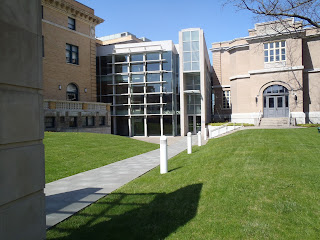This museum has an urban setting. I got there by walking through Washington Park and down Washington Avenue form my house. I went there from 3 to 5pm on a Friday, so the streets around the museum were quite busy, but the museum itself was not very busy.
The building to the left, seen in the top picture, holds the museum shop, various meeting rooms, and offices. The building to the right, seen in the bottom picture, holds the art galleries. The glass-walled atrium connects the buildings and includes a stairwell, elevator and welcome desk.
The historic buildings are made with masonry, while the modern atrium is made with glass and steel. The atrium reflects the International Modern Style, but perhaps with a postmodern uniqueness that adds interest.
The interior of the museum reflects the exterior. The atrium is very modern with clean, sleek lines and a certain impersonal sterility. There is certainly an economy of means in this part of the museum. The interior of the historic buildings, however, is somewhat more elaborate and decorative. The contrast between the modern and historic parts of the museum is best exemplified by the stairwells. The stairs in the atrium are in straight lines and made of stone tiles polished to a matte finish. The stairwell in the 19th century sculpture exhibit, however, is a double staircase that frames the room with its curved lines. It is more decorative and suggestive of grandeur than the atrium stairs. Despite these contrasts, the two interior styles are unified by the fact that part of the previous exterior walls of the older buildings are visible inside the atrium.
I decided to focus on the 19th century sculpture collection, which is displayed on two stories in the historic atrium with curving stairs that is described above. There aren't really specific cues about how to progress through the exhibit because it is a pretty open space. This exhibit displays the institute's collection of sculpture by Erastus Dow Palmer and his assistants Launt Thompson, Charles Calverley, and Richard Park. Erastus Dow Palmer was a local artist. The collection includes busts, full-body sculptures and framed bass reliefs. I thought it would be interesting to focus on work form the same time period and same general region as the paintings that I focused on from the Arkell Museum but in a different medium and form.
Retrieved from http://www.albanyinstitute.org/details/items/taking-comfort.html
The first piece that I chose to describe is Taking Comfort by Charles Caverley (1879). This is a circular, plaster bass relief depicting a young child sucking his or her thumb.
Although the only color is white, this piece uses light because shadow is necessary to view the form of the subject. Furthermore, this manipulation of light is done with the actual texture of the piece, or its contours. What is interesting is that the actual texture and the light cause an simulated texture. Specifically, the texture of the hair, cloth and skin are all implied. While the names seems to refer to the fact that the child is sucking his or her thumb, the pure whiteness of the piece amounts to an interpretive use of color to symbolize purity and serenity.
http://www.albanyinstitute.org/details/items/peace-in-bondage.html
The second piece that I am featuring is Peace in Bondage by Erastus Dow Palmer (1863). This is also a plaster bass-relief. It features an angel who appears to have her hands tied behind her back. It is meant to symbolize the violence during the Civil War (see Albany Institute of History and Art, 2013).
This piece also uses light because the shadows reveal the form of the angel and tree. This is done with actual texture, or contours, in the plaster. This simulates the texture of skin, hair, the tree, and feathers.
Interestingly, while the white color of the previous piece evoked a feeling of serenity, this piece has a feeling of tension despite the purity of the white.

http://www.albanyinstitute.org/details/items/sanford-robinson-gifford.html
The third and final piece that I observed in this gallery is Sanford Robinson Gifford by Launt Thompson (1871). Unlike the others, this one is made of casted bronze, so it is a brownish color, not white. Also, this bust is viewed on all three sides, unlike the bass- reliefs.
I feel like the brown color gives this sculpture a stately feel. This sculpture uses light to its advantage not with shadow, but with reflection. The reflected light off of the convex contours of the bust lend to the three-dimensional appearance. For example, the detail of the cheekbones is illuminated with these reflections.
I love the Albany Institute of History and Art, and I like to visit here periodically to see more of the permanent exhibits and the new temporary exhibits. It is a great museum within walking distance form where I live.
References
Albany Institute of History and Art. (2013). Collection details: Peace in Bondage. Retrieved from http://www.albanyinstitute.org/details/items/peace-in-bondage.html




No comments:
Post a Comment